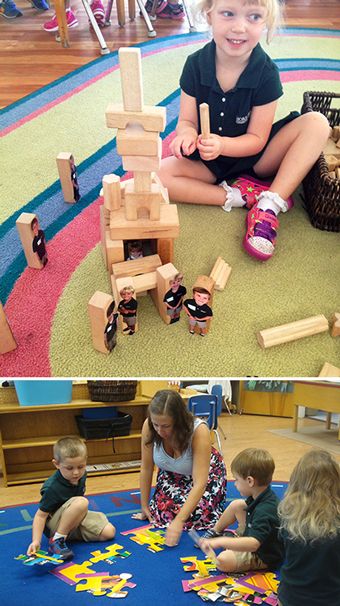

Week of 9-5-2014
Source/Author: Betty Gootson
September 05, 2014
For each story below, there are corresponding pictures here.
Making our motto meaningful
The Shorecrest motto, “At Shorecrest, we respect ourselves, each other and the environment.” is recited daily in the Experiential School of Tampa Bay. To be sure its recitation is more than rote, the Junior Kindergartners analyzed it in relation to the behaviors and actions they deem important. Step one was sharing the actions they think are important to remember. These thoughts then were written on strips and passed out randomly. Each student took the action he/she received and, with the help of their classmates, decided which aspect of the motto it related to respecting: themselves, each other, or the environment. The end result - the knowledge that our motto truly is an all encompassing rule to live by!
Making our motto meaningful
The Shorecrest motto, “At Shorecrest, we respect ourselves, each other and the environment.” is recited daily in the Experiential School of Tampa Bay. To be sure its recitation is more than rote, the Junior Kindergartners analyzed it in relation to the behaviors and actions they deem important. Step one was sharing the actions they think are important to remember. These thoughts then were written on strips and passed out randomly. Each student took the action he/she received and, with the help of their classmates, decided which aspect of the motto it related to respecting: themselves, each other, or the environment. The end result - the knowledge that our motto truly is an all encompassing rule to live by!
Circles in our environment and art
The Alpha children have been exploring circles! They talked about the attributes of a circle and named things they know that have a circular shape. They then searched for circles around the classroom and printed circular designs using common objects such as toys, cups, paper towel rolls and more in the shape of a circle as the "paintbrush".
It is always busy in the Experiential School – we live up to our name!
Building a community
One activity that consistently draws students is blocks. When you add people blocks, it makes them even more attractive, and when those people are your classmates, it gives the play a whole new dimension! The children act out scenarios that reflect their actual social experiences and helps them practice entering play, compromise and conflict resolution.
Learning teamwork
Floor puzzles are a great vehicle for teaching teamwork and cooperation. In Alpha, a teacher may join the students to facilitate sharing the pieces, taking turns, and helping our friends. She also models how to use the shapes of the pieces and the colors and pictures to figure out how the pieces go together. Working together at tables with a variety of manipulatives is another way that the children learn to share and work together, as well as develop their language and communication skills as they have conversations about what they are doing.
What does a scientist do?
 Hands-on science plays a major part in Junior Kindergarten as the children learn about their environment and natural world. The first question for the children to answer before they embarked on these studies is “What does a scientist do?” They came up with some credible and creative answers, many of which gave the teachers information about the children’s interests and, therefore, direction for their plans. See the picture of the web with one class’ answers! The second step towards conducting scientific studies was to create science journals for the documentation of their science investigations and discoveries. Creation of the journals included practice in categorizing, cutting, and control of glue as the children found pictures related to science in magazines and arranged them collage fashion on their journal covers. Let the investigations and experiments begin!
Hands-on science plays a major part in Junior Kindergarten as the children learn about their environment and natural world. The first question for the children to answer before they embarked on these studies is “What does a scientist do?” They came up with some credible and creative answers, many of which gave the teachers information about the children’s interests and, therefore, direction for their plans. See the picture of the web with one class’ answers! The second step towards conducting scientific studies was to create science journals for the documentation of their science investigations and discoveries. Creation of the journals included practice in categorizing, cutting, and control of glue as the children found pictures related to science in magazines and arranged them collage fashion on their journal covers. Let the investigations and experiments begin!How big are we?
When the Alpha teachers weighed the students and measured their height, it created a whole new area of interest as the children love to compare their heights marked on the wall. What a natural way to learn to about size comparison and the terms taller, shorter, and equal.
Creating patterns
Figuring out how to fill in pictures using pattern blocks can be challenging as children develop spatial awareness and reasoning and use visual discrimination and trial and error. They also can be used creatively. When given the blocks and empty frames, the JK students came up with some pretty amazing patterns, designs, and pictures.
Keeping the beat
Steady beat is the most fundamental property of music and life. So, it is not surprising that it is the very first skill that our youngest students experience, and will continue to focus on in music class. Beginning with body percussion and rhythmic chants, students pat the steady beat on their legs. We quickly move to patting the beat on a drum with the rhythmic chant. With each repeated steady beat activity, the early neural networks are laying a solid foundation upon which much more information will be connected.
Those old fashioned games!
Remember all the games you used to play before the technology invasion, the kind that came in a box? Playing those games teaches sportsmanship, turn taking, and cooperation. They can also reinforce specific skills. This week, playing Bear Bingo reinforced size and color discrimination while Go Fish involved numeral recognition and counting. Be sure to look at the corresponding picture to see the ingenious way the children were able to hold and view their cards privately!
[view the week's photos]







![JK on the Run [Photos] JK on the Run [Photos]](/Images/1px.png?command_1=url&url_1=https%3A%2F%2Fwww.shorecrest.org/userfiles/shpsv2mvc/images/news-images/JKontherun.jpg&command_2=resize&height_2=85)















.jpg&command_2=resize&height_2=85)
